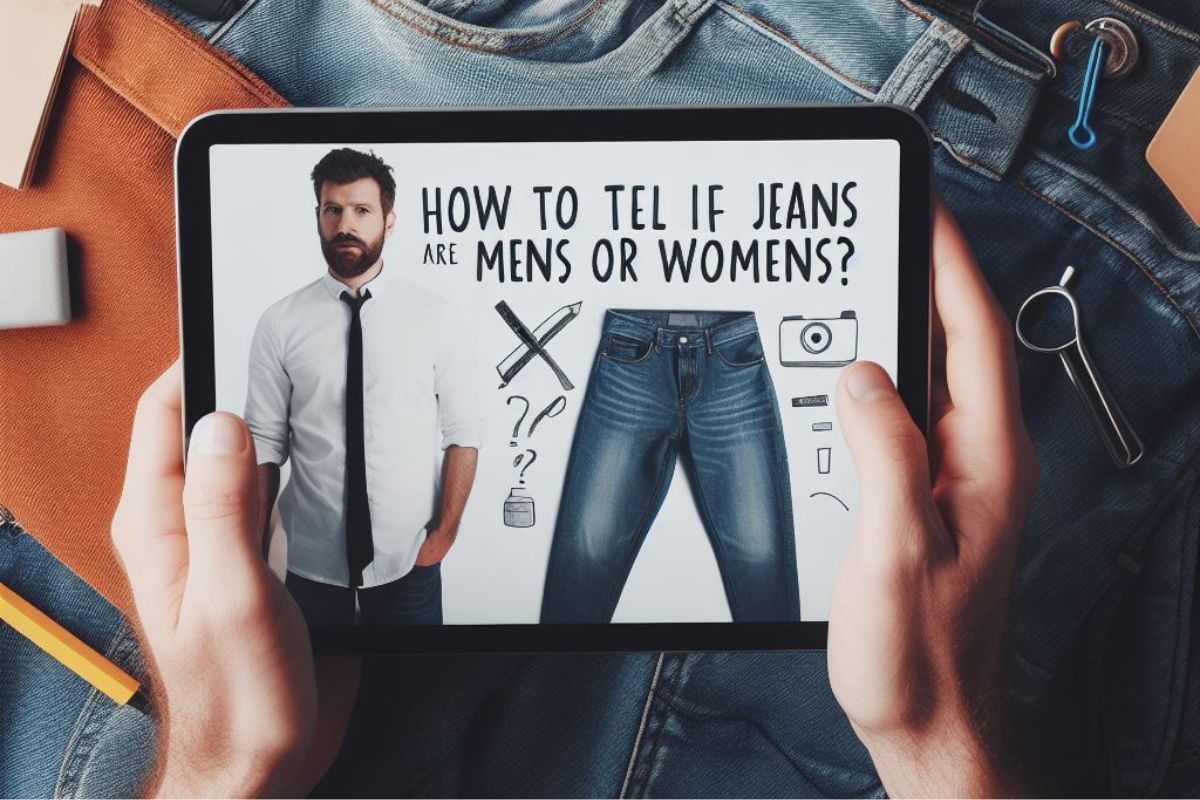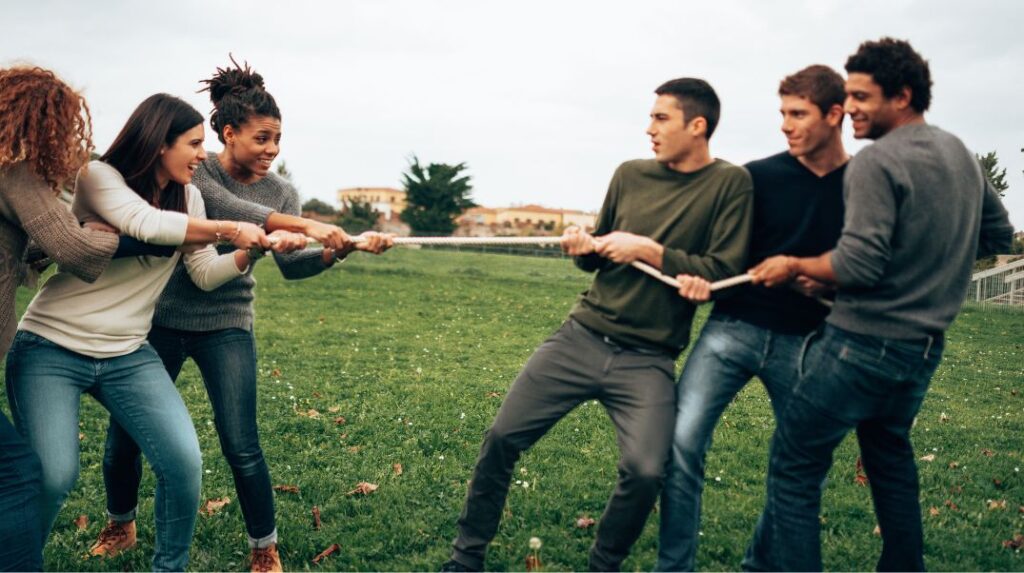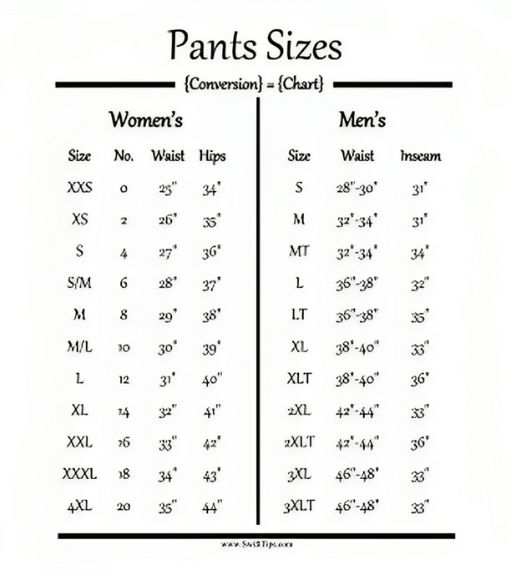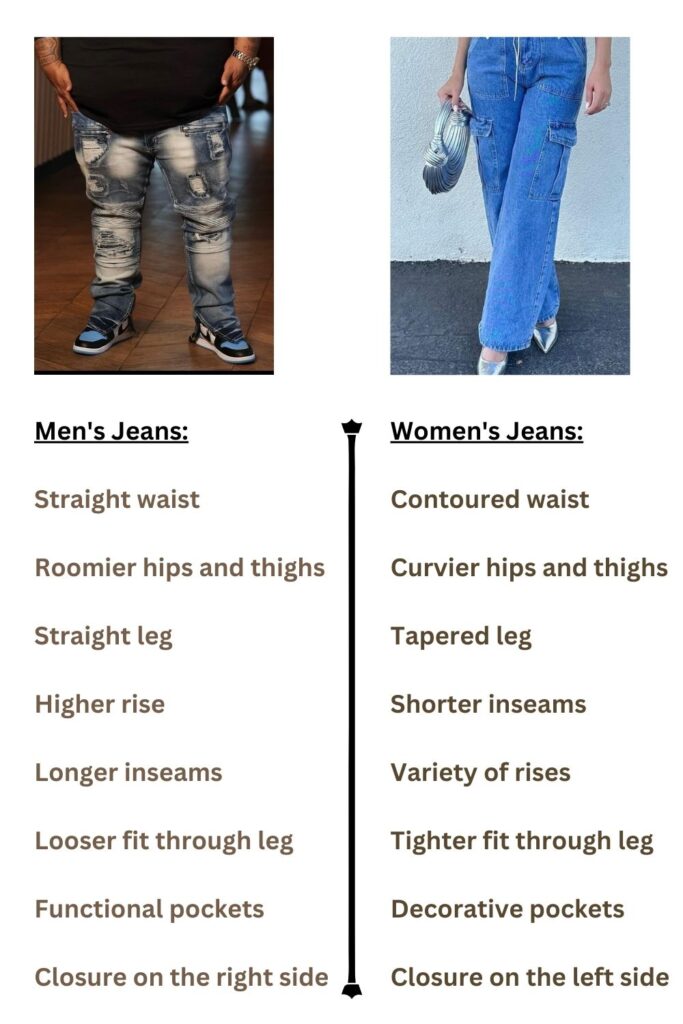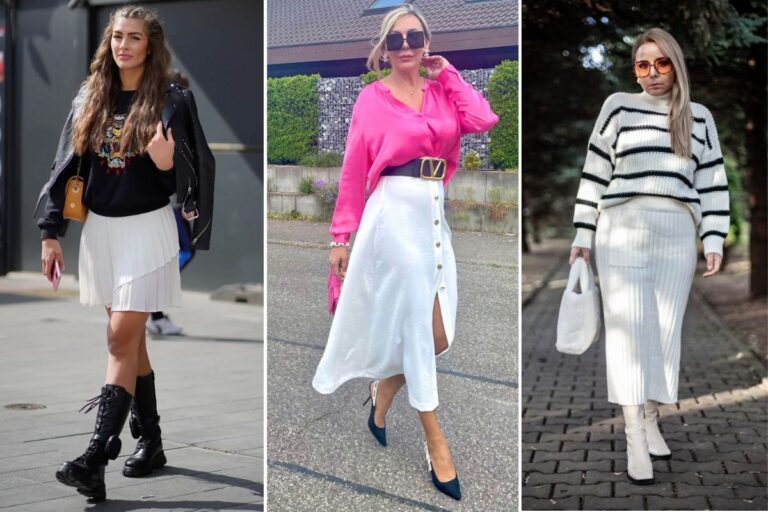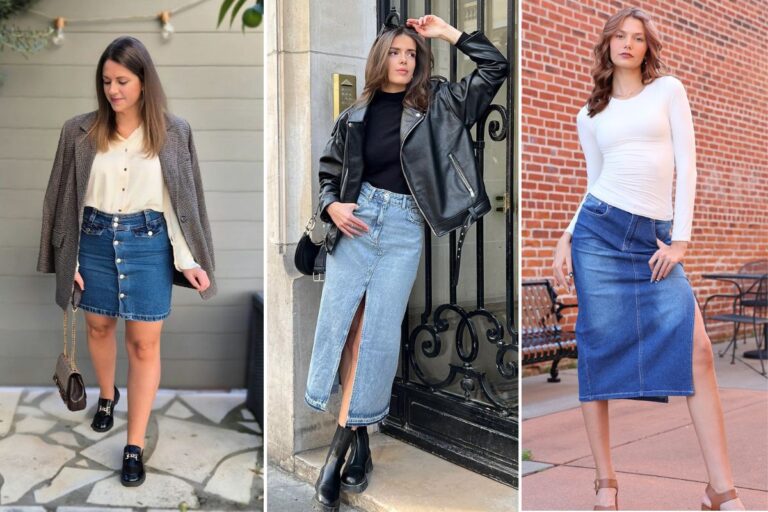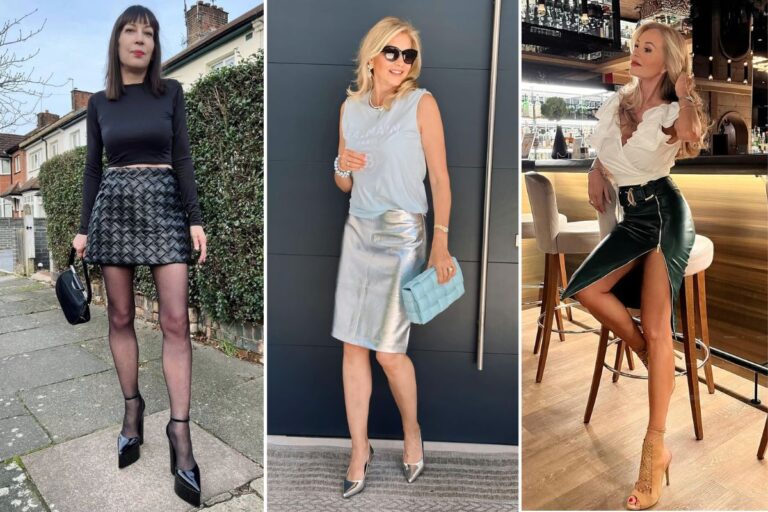I used to get so confused trying to shop for jeans, never knowing if I was in the men’s or women’s section. The subtle differences between men’s and women’s denim styles made it tricky for me to tell them apart. After accidentally buying the wrong fit a few times, I knew I needed to learn how to properly identify women’s jeans.
In this post, I’ll share the key differences I’ve learned between men’s and women’s jeans to help other women avoid the same confusion.
I’ll outline the major distinctions in fit, style, sizing, and design so you can shop for jeans confidently. Whether you’re buying jeans for yourself or someone else, understanding what to look for can ensure you get the right fit.
Let me walk you through the tell-tale signs of women’s jeans versus men’s.
Key Differences Between Men’s and Women’s Jeans
While jeans may appear similar at first glance, there are some notable differences between men’s and women’s styles. Here are the most important factors to consider:
Sizing and Fit
The most obvious difference is in the sizing and fit. Women’s jeans are designed to fit an hourglass silhouette, with a narrower waist and wider hips and thighs. Men’s jeans sit at the waist and are straight through the hip and thigh.
Women’s jeans come in numerical sizes like 0, 2, 4, etc. Men’s jeans use waist and inseam measurements like 30 x 32.
Women’s jeans emphasize curves while men’s have a straight fit. Men’s jeans are roomier in the seat and thighs.
Styles and Cuts
The range of fits and styles is wider in womenswear. Popular options include skinny, bootcut, flare, and mom jeans. Menswear leans toward classic straight leg, slim, and relaxed.
Women’s jeans often taper towards the ankle while men’s have a straight leg. The leg opening is wider on men’s jeans.
Rise
The rise refers to the distance between the crotch seam and waistband. Men’s jeans have a mid to high rise, sitting near the belly button. Women have options like low, mid, and high rise.
A lower rise is more common and flattering in womenswear. Higher rises emphasize curves on a woman’s body.
Details and Branding
Women’s jeans tend to have more decorative details like embroidery, rhinestones, and distressing. Men’s jeans opt for a more minimalist aesthetic.
Many brands use feminized naming and terminology like “super skinny” on women’s styles. Men’s jeans often highlight durability and utility.
Women’s back pockets are rarely functional while men’s pockets are designed for use. The shape is also different, with women’s being contoured and tapered.
Fabrics and Washes
The denim itself differs between men’s and women’s jeans. Women’s fabrics are softer and lighter while men’s feature heavier, rigid denims.
Men’s jeans come in darker indigo washes while women can choose from a wide range of colors and fades. Distressed details are also more prominent in womenswear.
Labels and Branding
Many jeans include clear “men’s” or “women’s” labeling. But for more gender-neutral brands, consider the styling and branding cues.
Masculine names, terminology, and label designs signal men’s jeans. Feminine details suggest womenswear. Unisex cases are trickier to decipher.
Men’s Jeans Size vs. Women’s Jeans Size
Along with differences in fit and style, the sizing of men’s and women’s jeans differs. Let’s break down the key points of distinction:
Waist Size
The waist measurement is the main numeric size listed. Men’s waists are represented in inches, like 30, 32, 34. Women’s waists also use inches but run smaller, around 26-36 inches.
A women’s size 4 jean typically has a 26-inch waist. The same waist size in men is around 30 inches.
Hip Measurement
Women’s jeans take hip size into account, listed in inches. A size 4 could be 36 inches around the hips. Men’s jeans do not factor in hip size.
Since women have wider hips, this measurement is key to getting the right fit. Men’s jeans have more room through the hips.
Rise Measurements
As mentioned earlier, the rise differs significantly. Women’s jeans come in low, mid, and high-rise options. Men’s rises are mid to high.
A “short” rise in womenswear may be just 7 inches. Men’s rises start around 10 inches and go higher.
Inseam Length
Men need longer inseams to fit their taller frames. Standard men’s inseams are around 32 inches. Women average between 28-30 inches.
Petite and tall-size jeans have varying inseams to accommodate different heights. Men have less variation in inseam by height.
The “Curvy” Factor
Many brands now offer “curvy” fits in womenswear. These styles have more room through the hips and thighs to accommodate curves. Men’s jeans do not have a curvy fit.
If you have an hourglass figure, a curvy style may provide a better fit than a standard women’s jean.
What Side Is the Button on Men’s Jeans?
An easy way to identify men’s jeans is to look at the placement of the closure. On men’s jeans, the button is on the right and the zipper is on the left. The opposite is true of women’s jeans.
This contrasting configuration stems from traditional gender roles. Men dressed themselves, so the button was placed on the right for convenience. Women were dressed by maids, so the left side button enabled right-handed maids to easily close them.
Today, the norm remains for men’s closures to be on the right and women’s on the left. It’s an instant indicator of whether jeans are made for men or women.
Some unisex styles may buck this trend, so it’s not an absolute rule. But in most cases, it’s a clear giveaway of the jeans’ intended gender.
Can Women Wear Men’s Jeans?
Women have more flexibility when it comes to wearing men’s jeans. The looser fit actually makes men’s jeans a desirable option for women looking for a relaxed, boyfriend style.
Some tips for women wearing men’s jeans include:
- Size down for a less baggy fit.
- Roll or cuff the hems if they are too long.
- Wear a belt to define your waist.
- Choose a slimmer men’s style, not a baggy one.
- Pair them with feminine tops to balance the look.
The looser cut of men’s jeans allows women to achieve a cool, laidback vibe. Going up 1-2 sizes or choosing slim fits prevents an overly boxy shape.
Men can also wear women’s jeans, but it’s a bit less common. The tighter fit would require sizing up 1-2 sizes. Stretch fabrics also help achieve a fitted look.
Men’s Jeans vs. Women’s Jeans: Visual Differences
To summarize the key distinctions, here is a visual guide to how men’s and women’s jeans differ in their cut and dimensions:
These characteristics provide a helpful cheat sheet when trying to quickly discern if a pair of jeans is designed for men or women before looking at labels, size charts, etc.
Do Men and Women Need Different Jeans Fabrics?
The choice of denim and other fabrics differs between men’s and women’s jeans for a few reasons:
Breathability
Women tend to prefer lighter, more breathable fabrics that contour to their body throughout the day. Men are more focused on durability, so they opt for thicker, stiffer denims.
Stretch
Stretch denim and fabrics with spandex help jeans mold to the body’s curves. Women gravitate toward stretch fabrics for a flexible fit. Men don’t require as much stretch or flexibility.
Hand-feel
Women want fabrics that feel soft and smooth against the skin. Jeans that rub or chafe are unacceptable. Men are less concerned with hand-feel and comfort.
Wear over time
Men need rugged, rigid denims that maintain their structure over years of wear. Women’s wear sees faster turnover in styles, so longevity is less important.
Aesthetic
The distressed details and varied faded effects achieved in womenswear require more flexible, malleable fabrics. Men’s fades and creases form naturally through wear.
Are Pockets Placed Differently on Men’s vs. Women’s Jeans?
Yes, the placement and design of pockets differ on jeans for men versus women:
Front Pockets
Women’s front pockets are set higher on the thigh and are angled and tapered. Men’s front pockets sit lower and have a wider, square shape.
Women’s front pockets are also less functional. They are smaller and often just stitched-on accents rather than usable pockets.
Back Pockets
Men’s back pockets are traditionally patch pockets, with a rectangular flap sewn on top. Women’s back pockets have an angled or curved shape for a contoured look.
Many women’s jeans have fake back pockets that are just decorative stitching or accents. Again, functionality is not a priority.
Coin Pockets
The tiny coin pocket is placed differently, too. Men’s coin pockets sit along the right front waistband. Women’s coin pockets are on the front right hip or thigh.
Do Seams Differ on Men’s vs. Women’s Jeans?
Jeans contain both exterior seams that decorate and shape the jeans along with interior seams that provide structure and put together the fabric pieces. Both types of seaming differ between men’s and women’s jeans.
Interior Seams
Women’s jeans typically have an inner curved waistband to hug the contours of the waist and upper hip. Men’s waistbands are straight across.
The crotch curve also differs to accommodate body shape. Women need more room, so the inseam seam has a deeper curved shape.
Exterior Seams
Decorative details like contrast stitching and whiskering follow the lines of the body and are placed to flatter curves on women’s jeans.
Men’s details emphasize straight lines and a vertical appearance. The styling helps lengthen men’s figure.
Curved hip yokes, scooped front pockets, and angled back pockets all place emphasis strategically for a woman’s form.
Do Men and Women Wear Jeans at Different Heights?
Yes, the waist height and rise are typically different between men’s and women’s jeans.
Men prefer a higher waist that sits at or near the belly button. The longer rise provides good coverage and a flattering balance to their proportions.
Women have a lot of flexibility when it comes to rise. Ultra low-rises help elongate the leg. Mid-rises are universally flattering. High rises accentuate curves and a nipped-in waist.
Here are some common rise measurements:
Men’s Rises
- Low rise: 10-11 inches
- Mid rise: Around 12 inches
- High rise: 13+ inches
Women’s Rises
- Low rise: 7-8 inches
- Mid rise: 9-10 inches
- High rise: 11+ inches
In general, women have a wider range of rise options while men stick to medium to higher rises in their jeans selection.
Men’s Jeans vs. Women’s Jeans: The Best Brands
Certain brands are go-to names when shopping for jeans by gender. Here are five of the top brands for men and women:
Best Men’s Jeans Brands
- Levi’s – The OG, Levi’s invented men’s jeans for the rugged and outdoorsy. Their classic straight and slim fits remain bestsellers.
- Wrangler – Known for cowboy-approved styles, Wrangler makes durable jeans that can withstand hard work. Great relaxed and loose fits.
- Lucky Brand – A modern, SoCal inspired brand making jeans with a perfect fade. Their slim and skinny fits are flattering on most men.
- Banana Republic – For polished, office-ready menswear, Banana Republic nails chino and denim with an upscale feel.
- Madewell – Though Madewell also makes stellar women’s jeans, their men’s fits get rave reviews for quality fabrics and minimalist styles.
Best Women’s Jeans Brands
- Levi’s – Along with being the OG for men, Levi’s also makes curve-flattering women’s jeans in cool distressed and vintage washes.
- Joe’s Jeans – Known for their fit, Joe’s Jeans are designed to mold perfectly to a woman’s figure in their skinny and slim fits. Great stretch recovery.
- J Brand – Using luxury Japanese denims, J Brand jeans have an ultra-soft handfeel and sculpted, slimming fits.
- Citizens of Humanity – This LA-based brand excels at skinny and slim bootcut styles that contour curves and elongate legs.
- Hudson Jeans – With options from ankle to flares, Hudson nails fits that accentuate a woman’s shape without uncomfortable waistbands or restrictive rises.
Finding the Right Men’s and Women’s Jeans – Conclusion
Jeans shopping certainly looks different today compared to the rigid gender divisions of the past. While some differences remain between men’s and women’s styles, brands increasingly recognize the need for inclusivity and versatility in denim.
Use this guide to familiarize yourself with the different design elements, naming conventions, fits, rises, and fabrics used in jeans for men versus women. With that knowledge, you can confidently select jeans aligned with your personal style and body type.
Don’t be afraid to break gender “rules” by dressing outside the traditional boxes. Mix and match these concepts to create a denim wardrobe perfect for your needs. With so many great options now available, you can easily discover the best jeans for you regardless of old stereotypes.
We hope this detailed overview gave you the insights you need to decide if jeans are made for men or women. What are your favorite jeans brands and fits? Do you like wearing styles outside of their intended gender? Let us know in the comments below!
